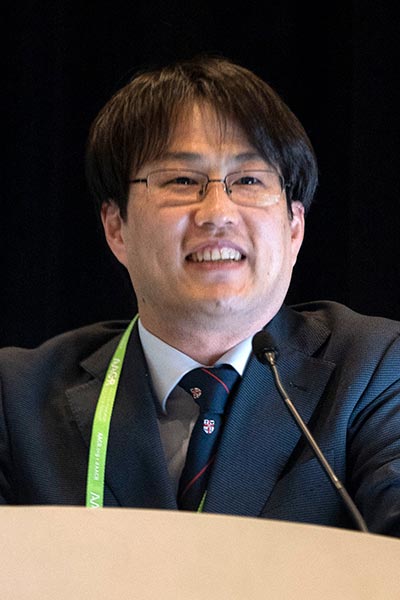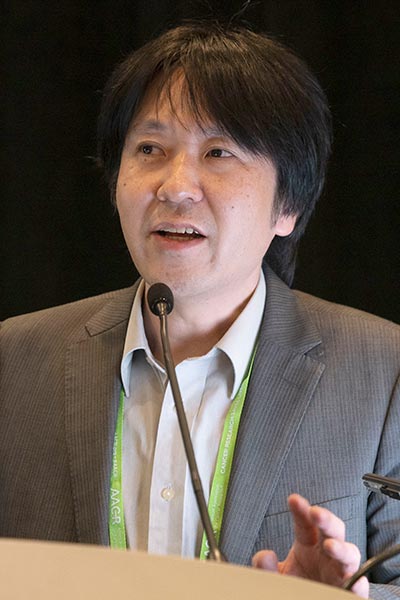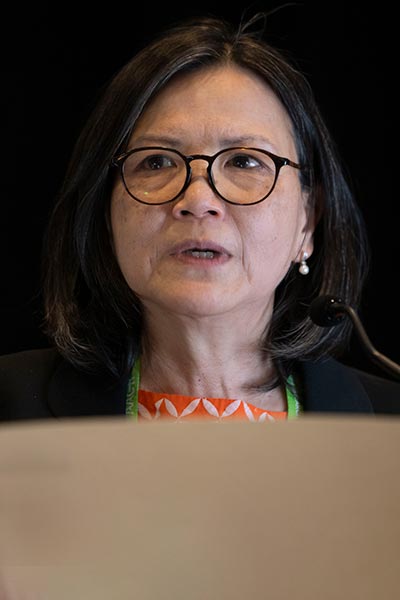AACR-JCA joint session discusses disruption of differentiation in neural tumors
Brain cancer often appropriates the normal developmental pathways that guide the maturation of neural cells. A joint session of the American Association for Cancer Research (AACR) and the Japanese Cancer Association (JCA) at the AACR Annual Meeting 2025 in Chicago explored the mechanisms by which tumors commandeer these processes.
During AACR-JCA Joint Session: Aberrant Neural Mechanisms in Brain Tumor Development and Therapy, speakers addressed tumorigenic mechanisms driving the pediatric brain cancers medulloblastoma and embryonic tumor with multilayered rosettes (ETMR), as well as glioblastoma, which is most common among older adults. Their presentations touched on how new insights into these cancers can lead to new therapeutic targets.
Finding mutations in repetitive regions of the genome

Hiromichi Suzuki, MD, PhD, of the National Cancer Center Japan, discussed the identification of specific mutations that disrupt neural cell differentiation, leading to medulloblastoma.
He and colleagues analyzed repetitive genomic regions involved in regulating transcription to identify these novel mutations. Their search led them to mutations in U1 snRNA, a component of the spliceosome, that occur in 50% of cases of the Sonic Hedgehog (SHH) glioblastoma subtype.
Mutations in U1 snRNA result in aberrant splicing of two genes within the SHH pathway, leading to accelerated SHH signaling and medulloblastoma development, Suzuki noted.
In the group 3 and group 4 medulloblastoma subtypes, Suzuki and colleagues identified mutations in the transcription factors CBFA2T2 and CBFA2T3, which are expressed in neural progenitors in the rhombic lip of the developing hindbrain. Mutations in the CBFA complex interfere with cell differentiation in this region, leading to medulloblastoma, he said.
“Medulloblastoma is strongly associated with abnormalities in neural differentiation, so [these findings] may lead to novel therapies, such as targeting the vulnerability of the cell of origin,” he said.
Chromatin rewiring fuels tumor growth

Daisuke Kawauchi, PhD, of Nagoya City University in Japan, discussed how the rewiring of chromatin structure impairs differentiation and fuels the growth of medulloblastoma.
Kawauchi and his colleagues looked at changes in chromatin compaction in normal, precancerous, and cancerous cells. This revealed that the NF1 family of transcription factors bound open regions of chromatin in precancerous and cancerous cells, but not in normal cells, suggesting that NF1 may regulate cell growth only in premalignant and malignant states—tantamount to “oncogenic hijacking by the NF1 protein,” Kawauchi said. Further investigation showed that NF1 regulated differentiation in these cells and that inhibiting NF1 may be effective in slowing medulloblastoma growth.
The researchers also looked for upstream events that reshape the epigenome. They found that mutations in the epigenetic regulators CHD7 and KMT2C altered histone modification in a way that reduced expression of the NEUROD-1 gene and inhibited differentiation of neural cells to promote tumor growth.
Driving heterogeneity within ETMRs

Annie Huang, MD, PhD, of the Hospital for Sick Children, discussed the role of C19MC, a cluster of 56 microRNAs, in highly aggressive ETMR cancers.
ETMRs can contain cells that vary from primitive- to mature-looking, the proportions of which can differ substantially within individual tumors. Huang’s lab found evidence suggesting that gene fusions involving C19MC drive the diverse composition of these tumors.
The C19MC locus is highly unstable, prone to DNA-shattering events called chromothripsis and to fusions with other genes, which can further promote C19MC expression, as well as that of other oncogenes.
Single-cell analysis revealed a relationship between the expression of C19MC and cell status: the more C19MC, the more primitive and stem-like the tumor cells. But as C19MC expression drops, cells come to possess more markers of differentiation.
“It is very likely that C19MC is operating like a gradient and a rheostat, and [that it] promotes its oncogenic function in different cell types that brings to us a tumor that has many different neural cell types,” she said. As a highly unstable gene locus, “[C19MC] can generate many permutations and combinations of [fusion] partners to create this diversity.”
Targeting recurrent glioblastoma with CAR T-cell therapy

Sheila K. Singh, MD, PhD, of McMaster Children’s Hospital, described how the discovery of the involvement of axonal guidance in recurrent glioblastoma led to the development of a promising new therapeutic approach.
Patients with glioblastoma, often older adults, have poor survival times, the result of the “terrible” degree of therapeutic resistance harbored by recurrent tumors, according to Singh.
Functional genomic comparisons between recurrent tumor cells and normal neural stem cells led her and her colleagues to identify protein tyrosine phosphatase 4A2 (PTP4A2) as an essential gene driving the aggressive recurrent state.
Further analysis led them to the axonal development and guidance pathway, and to ROBO1, which mediates axonal guidance. Inhibition of PTP4A2 decreased ROBO1 expression, and blocking the activity of either PTP4A2 or ROBO1 reduced glioblastoma invasion.
“This insight really does expose a pathway-level vulnerability in recurrent glioblastoma cells,” she said.
The team designed ROBO1-targeting CAR T cells that have so far shown robust CAR T-cell activation, cytokine release, and tumor cell toxicity upon exposure to ROBO1-expressing recurrent glioblastoma models, she said.
The recording of the full session is available for registered Annual Meeting attendees through October 2025 on the virtual meeting platform.
More from the AACR Annual Meeting 2025
View a photo gallery of scenes from Chicago, continue the conversation on social media using the hashtag #AACR25, and read more coverage in AACR Annual Meeting News.

